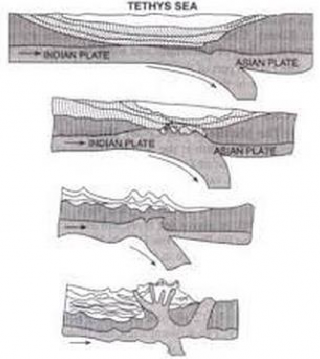2.2. The Himalayas
The Himalayas are geologically young, weak and flexible and structurally fold mountains unlike the rigid and stable Peninsular Block. The disintegration of Pangaea, about 200 million years ago, led to the formation of a long Tethys sea between the Lauretian Shield and Gondwanaland. This sea was occupying the region of Himalayas called geosyncline. About 65-30 million years ago, the Indian plate came very close to the Eurasian plate and started subducting under it (figure 5). This caused lateral compression due to which the sediments of the Tethys were squeezed and folded into three parallel ranges of the Himalayas. Since the northward movement of the Indian plate is still continuing, these mountains are still subjected to endogenic forces apart from exogenic forces. It is said that the height of the Himalayan peaks is still increasing.

